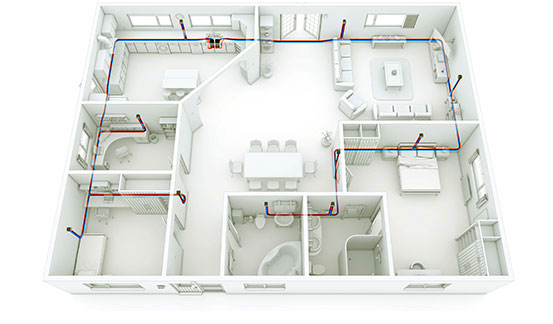13D fire sprinkler alternative for tiny homes, manufactured housing units (MHUs) and temporary sleeping cabins
Tiny homes, temporary cabins, and manufactured housing units (MHUs) have seen a rise in popularity across America. Typically smaller in size compared to traditional housing, they can be used to address homelessness or provide affordable housing. These dwellings can be customized to suit various needs and preferences, whether serving as a primary residence or temporary accommodation.
In addition to the challenges posed by limited space, small dwellings often face constraints in accommodating gas-fired heating units and wood stoves due to reduced clearance requirements. Unlike larger homes that offer multiple exits and escape routes, small dwellings may feature limited ingress and egress points, thereby heightening the risk of occupants becoming trapped or obstructed during an emergency. Moreover, the close proximity of combustible materials within the confined spaces of small dwellings can exacerbate the rapid spread of fire, further intensifying the potential hazards associated with fire safety in such environments.

Fire sprinkler systems are renowned for their effectiveness in suppressing fires and protecting lives and property in various structures. However, implementing traditional fire sprinkler systems in small dwellings, such as accessory dwelling units (ADUs), presents several challenges as they often lack the requisite room for accommodating large tanks and bulky pumps.
Small dwellings are often located in remote settings or some distance from the primary dwelling. Sometimes they rely on alternative water sources such as wells or tanks that may have limited capacity and flow rates, which can be insufficient to support the water demands of fire sprinkler systems. In regions with harsh winters, water connections must be insulated, or antifreeze applied which can add cost. There are instances where the property's existing water meter is too small to supply the fire sprinkler system with enough flow. In this case, a $2K–$5K cost will be paid directly to the water district to upgrade the water meter. If the existing publicly owned lateral is undersized (5/8”) an additional $25–35K may be required depending on the position of the water main in relation to the meter. If you are in an earthquake zone, the problems can be increased as movement can cause pipes to leak.
With this in mind, we designed Automist, an advanced fire protection system for smaller homes. It runs directly off the domestic water main, drawing only 2.4 gallons per minute. Because it is a ‘dry pipe’ system it is far less susceptible to burst pipes caused by freezing or seismic activity. Its footprint is only 9 inches by 7 inches, and 14 inches tall, compared to the standard one that takes up approximately 15 square feet. This will save owners more room, as it can fit in a cabinet or under the sink. Finally, it has been tested to exceed international standards and operates faster than glass bulb-activated systems. Fill out the form below to register your interest and be informed when Automist is available in your area.
